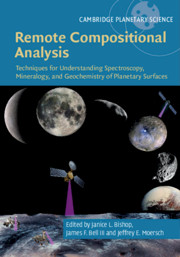 Remote Compositional Analysis
Remote Compositional Analysis Theory and Laboratory Spectra of Geologic Materials
from Part I - Theory of Remote Compositional Analysis Techniques and Laboratory Measurements
Published online by Cambridge University Press: 15 November 2019
This chapter describes the phenomenon of Raman scattering from the point of view of classical electrodynamics and quantum mechanics. Raman scattering is a type of inelastic scattering of light by molecules that changes the energy of a photon by the energy equal to a vibrational transition of that molecule. The symmetry of vibrational modes and the activity of vibrational modes in Raman spectra is discussed via group theory for molecules and minerals. The chapter describes how the information gleaned from Raman spectra can be used to identify structural information about a given sample and how this information can be useful to Earth and planetary scientists. The principal components of laboratory and remote Raman instrumentation are defined, including excitation sources, spectrographs, and detectors, and the ways in which recent advances in technology have facilitated the application of Raman spectroscopy for Earth and planetary science are discussed. Some technological advances include the development of reliable continuous wave (CW) and pulsed lasers at a variety of wavelengths, the advancement of multichannel detectors such as two-dimensional charge-coupled devices and photodiode arrays, and the coupling of optical accessories such as microscopes and telescopes. The applications of these advanced Raman systems in the fields of Earth and planetary science are highlighted.
To save this book to your Kindle, first ensure [email protected] is added to your Approved Personal Document E-mail List under your Personal Document Settings on the Manage Your Content and Devices page of your Amazon account. Then enter the ‘name’ part of your Kindle email address below. Find out more about saving to your Kindle.
Note you can select to save to either the @free.kindle.com or @kindle.com variations. ‘@free.kindle.com’ emails are free but can only be saved to your device when it is connected to wi-fi. ‘@kindle.com’ emails can be delivered even when you are not connected to wi-fi, but note that service fees apply.
Find out more about the Kindle Personal Document Service.
To save content items to your account, please confirm that you agree to abide by our usage policies. If this is the first time you use this feature, you will be asked to authorise Cambridge Core to connect with your account. Find out more about saving content to Dropbox.
To save content items to your account, please confirm that you agree to abide by our usage policies. If this is the first time you use this feature, you will be asked to authorise Cambridge Core to connect with your account. Find out more about saving content to Google Drive.